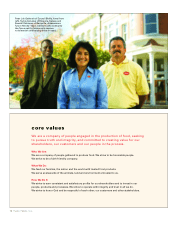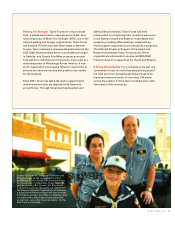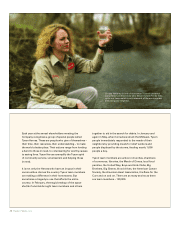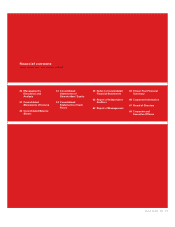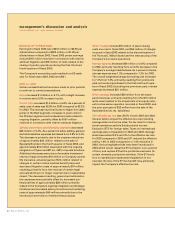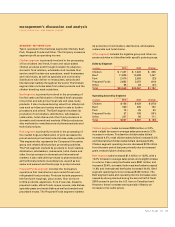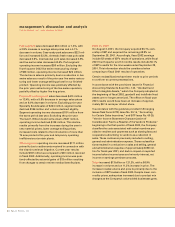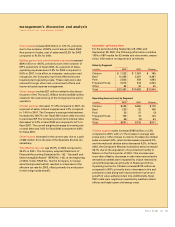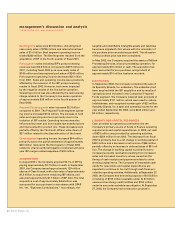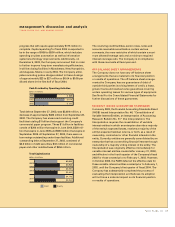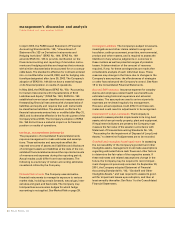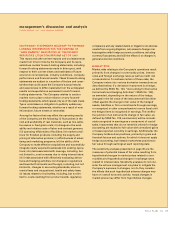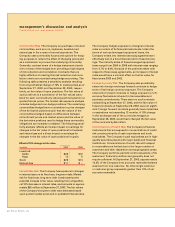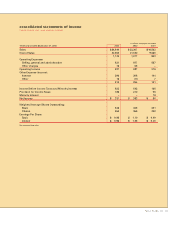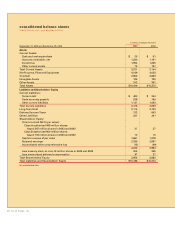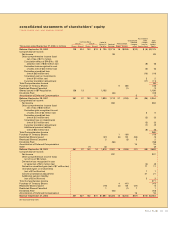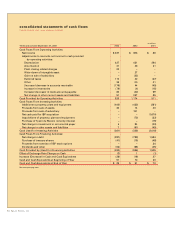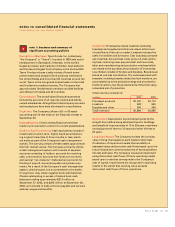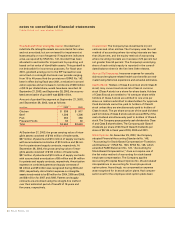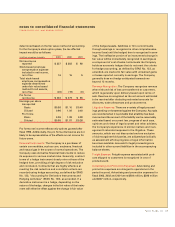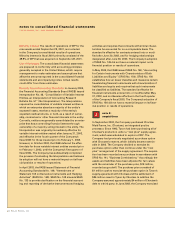Tyson Foods 2003 Annual Report Download - page 30
Download and view the complete annual report
Please find page 30 of the 2003 Tyson Foods annual report below. You can navigate through the pages in the report by either clicking on the pages listed below, or by using the keyword search tool below to find specific information within the annual report.
28 Tyson Foods, Inc.
management’s discussion and analysis
TYSON FOODS, INC. 2003 ANNUAL REPORT
In April 2003, the FASB issued Statement of Financial
Accounting Standards No. 149, “Amendment of
Statement No.133 on Derivative Instruments and
Hedging Activities” (SFAS No. 149). SFAS No. 149
amends SFAS No. 133 to provide clarification on the
financial accounting and reporting of derivative instru-
ments and hedging activities and requires that contracts
with similar characteristics be accounted for on a compa-
rable basis. The standard is effective for contracts entered
into or modified after June 30, 2003, and for hedging rela-
tionships designated after June 30, 2003. The Company’s
adoption of SFAS No. 149 did not have a material impact
on its financial position or results of operations.
In May 2003, the FASB issued SFAS No. 150, “Accounting
for Certain Instruments with Characteristics of Both
Liabilities and Equity” (SFAS No. 150). SFAS No. 150
establishes how an issuer classifies and measures certain
freestanding financial instruments with characteristics of
liabilities and equity and requires that such instruments
be classified as liabilities. The standard is effective for
financial instruments entered into or modified after May 31,
2003, and is otherwise effective in the fourth quarter of the
Company’s fiscal 2003. The Company’s adoption of SFAS
No. 150 did not have a material impact on its financial
position or results of operations.
CRITICAL ACCOUNTING ESTIMATES
The preparation of consolidated financial statements
requires management to make estimates and assump-
tions. These estimates and assumptions affect the
reported amounts of assets and liabilities and disclosure
of contingent assets and liabilities at the date of the con-
solidated financial statements and the reported amounts
of revenues and expenses during the reporting period.
Actual results could differ from those estimates. The
following is a summary of certain accounting estimates
considered critical by the Company.
Financial Instruments The Company uses derivative
financial instruments to manage its exposure to various
market risks, including certain livestock, natural gas, inter-
est rates and grain and feed costs. The Company may
hold positions as economic hedges for which hedge
accounting is not applied. See Market Risk on page 29.
Contingent Liabilities The Company is subject to lawsuits,
investigations and other claims related to wage and
hour/labor, cattle procurement, securities, environmental,
product and other matters, and is required to assess the
likelihood of any adverse judgments or outcomes to
these matters as well as potential ranges of probable
losses. A determination of the amount of reserves
required, if any, for these contingencies are made after
considerable analysis of each individual issue. These
reserves may change in the future due to changes in the
Company’s assumptions, the effectiveness of strategies
or other factors beyond the Company’s control. See Note
19 to the Consolidated Financial Statements.
Accrued Self Insurance Insurance expense for casualty
claims and employee-related health care benefits are
estimated using historical experience and actuarial
estimates. The assumptions used to arrive at periodic
expenses are reviewed regularly by management.
However, actual expenses could differ from these esti-
mates and could result in adjustments to be recognized.
Impairment of Long-Lived Assets The Company is
required to assess potential impairments to its long-lived
assets, which are primarily property, plant and equipment.
If impairment indicators are present, the Company must
measure the fair value of the assets in accordance with
Statement of Financial Accounting Standards No. 144,
“Accounting for the Impairment of Disposal of Long-Lived
Assets,” to determine if adjustments are to be recorded.
Goodwill and Intangible Asset Impairment In assessing
the recoverability of the Company’s goodwill and other
intangible assets, management must make assumptions
regarding estimated future cash flows and other factors
to determine the fair value of the respective assets. If
these estimates and related assumptions change in the
future, the Company may be required to record impair-
ment charges not previously recorded. On September 30,
2001, the Company adopted Statement of Financial
Accounting Standards No. 142, “Goodwill and Other
Intangible Assets,” and was required to assess its good-
will for impairment issues upon adoption, and then at
least annually thereafter. See Note 1 to the Consolidated
Financial Statements.


